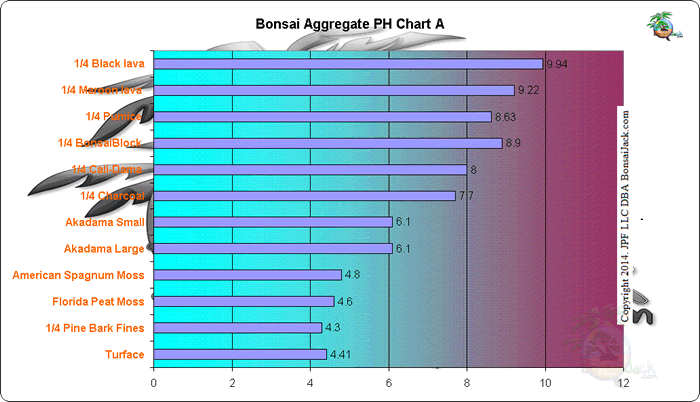Bonsai Soil / Aggregate Test Report 2014
Originally posted 12-30-2014
Bonsai Soil / Aggregate Test Report 2014
This post documents my journey to find the perfect bonsai soil mix. Hundreds of lab tests were performed. Two soil mixes were developed from these tests. This
is a long technical post. Scroll to the bottom to view the results if you prefer to skip the technical details.
Chart A: This chart shows the pH value of several
ingredients.

Chart B: This chart shows bulk density. Aggregate weight per cubic inch.

Chart 3: This chart shows the increase of aggregate water weight over the original dry weight, over time. Example: Pumice increased by 16.49% after soaking in water for 24 hours. After 24 hours of drying it was 5.41% heavier than the dry weight. After 48 hours of drying it was only .27% percent heavier than the original dry weight.
Pumice is a great aggregate as it absorbs and releases water in short period of time. The opposite would be an aggregate such as Turface which absorbs water and holds onto it. Pumice and pine bark fines are perfect ingredients and should be included in every mix.
Cali-Dama is the heaviest aggregate. It absorbs the least amount of water.

Chart 4: Lets look at the data from another point of view.
Here is a chart showing the actual moisture absorption and retention rates regardless of the aggregate weight.
Same data, different aspect. Example: Maroon Lava absorbed .088 ounce of water. After 24 hours of drying the aggregate retained .042 ounces of the original .088 ounces. After 48 hours that value decreased to .021 ounces. A good result.
Black lava, pumice, BonsaiBlock and pine bark fines also scored well.

This section of the report will cover soil mix pH levels using aggregates we offer. The tests were performed in order to establish two good universal mixes. Its a bit
complicated.
Refer to chart 7 for organic mixes and chart 8 for inorganic mixes. Locate a mix of interest and note the mix number. Example 11110A. Then refer to chart 5 or 6 to view the pH value.
The charts show each ingredient by part. Example: 221000 contains two parts BonsaiBlock, two parts Pumice and one part Pine Bark Fines. Here is the legend…
BBLOCK PUMICE PBF LAVA TURFACE CHARCOAL
0=0 parts
1=1 part
2=2 parts
A=10% of a part
B=20% of a part
C=33% of a part
D=50% of a part
E=75% of a part
F=5% of a part




Note on above charts: You can see how some aggregates react to each other. Turface for example. A little bit of this aggregate will affect your pH. Its a great acidifier in controlled portions. The pH difference between a mix containing a little or a lot of Turface is miniscule.
This chart shows water absorption and release rates of 4 mixes over time. Two are BonsaiJack and the other two are popular mixes here in Florida. The ideal soil mix will absorb a good amount of water and release the majority of it between watering. Most bonsai are watered every 24 to 48 hours. One mix contains 7 digits. The additional digit is Akadama.

This chart shows the pH value of the same four mixes. The ideal universal pH for most container plants is 6.2. This is based on a report by Neil Mattson from Cornell. The report can be viewed HERE

RESULTS. My preferred soil mixes.
BonsaiJack 221 Organic Mix. This mix contains 40% BonsaiBlock, 40% Pumice and 20% Pine Bark Fines. The mix has a consistent 1/4 inch particle size with great absorption and release rates. The pH level is 6.4, slightly acidic.
BonsaiJack 11011 Inorganic Mix. This contains 25 percent each of BonsaiBlock, Pumice, Maroon Lava and Turface. It has a pH value of 6.7, slightly acidic. This mix has good water absorption and release rates. The mix contains a small amount of Turface that does not affect drainage or evap rates.
These soils and or ingredients for each can be purchased HERE.
Thanks for reading. Constructive feedback is always appreciated.
If you would like to see a mix or aggregate included in my next report please prepare a 2.5 quart sample and contact us via email.

Thank you for this information. I have a couple questions. How was the total ph of a mix determined? Was the ph of each component added and divide by its value to reach an agragate? Or was the entire mix tested for its PH?
Also, with Turface, the manufacture states its PH value is 6.5 +- 1. Just wondering how accurate that is.
I live in a hard water area. The PH of water is 7.5 to 8. I’m wondering if I water daily how long until it effects the ph value of the mix are affected, and how much buffering the mix provides after watering? Reason being, I am currently thinking of ph balancing my water. But would prefer to just add Turface to boons mix to lower to ph to 6.5. But was wondering how much Turface it would take to bring it down to that level, if Akadama remained 1/3 of the mix. Any thoughts on this would be appreciated. Thanks!
Hello Josh,
The pH results were determined by testing each mix or soil component in a lab.
You asked about Turface MVP labeling. It depends on the label you find. The latest one shows 5.5 give or take 1.0. I would say they are all pretty accurate. Montmorillonite is a great acidic component for bonsai soil. It’s a natural product and the pH will vary by particle size / bulk density. Monto Clay, which comes from the same mine as Turface, is 1/4 inch and has a pH level of 5.6(higher than 1/8th inch Turface MVP). This is because of the larger particle size and reduced overall surface area.
Water will affect the overall pH balance of your soil. I do not recommend trying to alter your water source. It would probably be easier to acidify the soil with Monto Clay, Turface or Pine Bark Fines.
You asked about how much Turface it will take to reach a pH of 6.5. This where it gets expensive. We have spent thousands of dollars lab testing blends to achieve a specific pH and water retention rate. It is trial and error and take months to get it dialed in. pH is a Dynamic variable. You cannot simply double one acidic ingredient in a mix to reduce the alkalinity by half. Each ingredient and volume will affect the outcome in ways that cannot be calculated on paper.
I hope this helps
Have a great week
Thanks
Jack
Hello,
How does the cactus/succulent gritty mix compare with the others? I imagine it falls below the 001110 but above 110110, thereby making it the second most water retentive mix out of the list. Taking into consideration water retention alone and risk of rot, such as for caudex succulents (and not considering pH which differs between these mixes), would the universal organic bonsai mix (221000) theoretically be more suitable for succulents, especially those that may be prone to rot? I’m surprised that the PBF absorb so much water, yet it is so frequently used. As usual, thanks for the help/input.
Hello Kswenk.
Good questions. The 101010 mix listed in the report is nearly identical to the modern version of our 111 mix. You asked how the modern version of our succulent soil would compare on the chart. If I had to guess, the water retention would be closer to the 221 mix because of the Montmorillonite particle size. You are correct. Pine bark does absorb a ton of water but it releases it very fast. Note the chart after 24 hours. This makes it an ideal ingredient for most mixes.
Succulent Soil mix #111 (not listed in the tests above) is the best choice for succulents. 221 will also work for some succulents such as desert rose but it’s not a perfect fit like the 111 mix. All of the soils tested are ultra-fast draining. It would be hard for a plant to have water damaged root systems when planted in any of the mixes. This is by design.
This report is very old and should only be used for general reference. I hope to have the data refreshed within a couple of years.
I hope this help.
Have a productive week.
Thanks
Jack
My life just got SO much more complicated…
In the 2nd chart from the bottom, the teal line in the key is 0101001. I am not seeing that code listed in the previous charts.
Thanks for the reply Ryan. I don’t recall every aspect of this report as hundreds of internal tests have been done since then. Its pretty dated. It looks like the bottom two charts included two other mixes for comparison purposes. “One mix contains 7 digits. The additional digit is Akadama. Two are Bonsai Jack and the other two are popular mixes here in Florida.” 0101001 would be equal parts of pumice, lava and Akadama.
I hope this helps.
Please call or email if you have questions or concerns.
Thanks
Jack